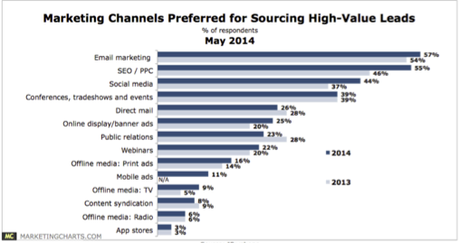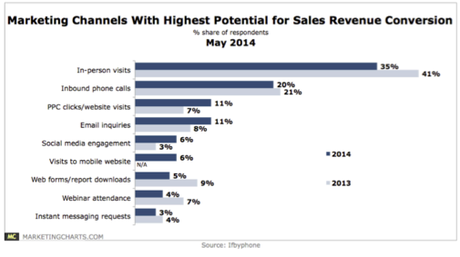 Have you ever considered that there might just be a formula for maximizing your business’s lead generation? If your B2B company is focused on lead generation (and let’s face it, who’s not?) there’s often a key component of lead gen that marketers are overlooking. And you know what? It’s not more content. Today, everybody’s smoking the “content is king” crack and wants to be in the content marketing business. While companies scramble to get their arms around that, rush to create and publish content and then sit back and wonder why the leads aren’t rolling in, c-suite execs and shaking their heads and declaring that there’s no ROI in content marketing and calling it a massive fail. The truth of the matter is that content, on its own, isn’t going to drive leads. You’ve got to factor in other extremely important components of an integrated marketing strategy, including SEO, the user experience you’re serving up and how you’re using social media. Lastly, if you really want to be successful at attracting and converting leads, you’ve got to understand how to connect what you’re doing offline with what you’re doing online. One rarely works without the other.
Have you ever considered that there might just be a formula for maximizing your business’s lead generation? If your B2B company is focused on lead generation (and let’s face it, who’s not?) there’s often a key component of lead gen that marketers are overlooking. And you know what? It’s not more content. Today, everybody’s smoking the “content is king” crack and wants to be in the content marketing business. While companies scramble to get their arms around that, rush to create and publish content and then sit back and wonder why the leads aren’t rolling in, c-suite execs and shaking their heads and declaring that there’s no ROI in content marketing and calling it a massive fail. The truth of the matter is that content, on its own, isn’t going to drive leads. You’ve got to factor in other extremely important components of an integrated marketing strategy, including SEO, the user experience you’re serving up and how you’re using social media. Lastly, if you really want to be successful at attracting and converting leads, you’ve got to understand how to connect what you’re doing offline with what you’re doing online. One rarely works without the other.
Reeling Them in With Online Marketing
When it comes to effective online lead generation, there are some key tactics that marketers should be using. These include:
User Experience. This isn’t mentioned enough when it comes to lead generation and improved conversions, so I’m going to lead with the fact that if you want leads, you have to deliver a great user experience. This is as true for B2B brands as it is for B2C brands, especially if you want more leads. If you use any kind of online marketing to draw prospects to your website and serve up a crummy user experience once they get there, chances are good you’ll never get the chance to covert that lead. Pay attention not only to the content on your website, but what kind of experience you serve up for customers on mobile devices. Make sure the content on your site is about them, and the problems they have (that you can solve) and not about how great you are. Make it easy to contact you and once they do, follow up quickly.
Email Marketing. At the very top of my list for improved conversions is email marketing. What we see all too often is that many B2B companies are either not using email marketing at all, or they’re not using it effectively as part of their lead generation efforts. Marketing Charts reports that some 57% of marketers prefer email marketing for sourcing high value leads. If you’re still doing untargeted email blasts and using your CTR as your only benchmark for success, you need to get with the proram. Email is highly convertible, provided you’re giving it the attention (fuelled by the right kind of content) that it deserves. A targeted, personalized email campaign that focuses on providing information that your prospects want and need and focused on adding value can be a great tool when it comes to lead gen. There are some basics that are important when it comes to better-performing email. First, know that email campaigns without A/B testing in place just don’t make sense, so put that at the top of your list. To increase the likelihood of your email reaching your recipients’ inboxes, make sure you pay attention to the small details. That means your email subject line has to be relevant and attention-grabbing (test these often), utilize personalization in your emails wherever possible, make sure the body of your email gets to the point quickly and, and most importantly, deliver something of value to the recipient at a time when they want and need it. This is where it’s critical to use your analytics data to help guide your email strategy. Not doing that yet? Start.
SEO and Pay-Per-Click Advertising. According to Marketing Charts’ data, SEO and Pay-Per-Click advertising (PPC) follow a close second as marketers’ preferred sources of lead generation, with 55% of respondents citing them as creating high value leads. This is also an area that we frequently find B2B companies doing poorly with. A website and any content you create as part of your corporate blog or other online marketing efforts should be driven by your SEO data. PPC campaigns can also be a great way of reaching highly targeted leads and search engine marketing of this nature should absolutely be a part of your integrated marketing strategies. Additionally, you can use targeted, personalized advertising on LinkedIn to reach the B2B audience, and you can get some great results using Facebook’s targeted ad platform to reach prospective buyers as well. It’s been our experience that many B2B companies either don’t use these tactics at all or they try the DIY approach without any real understanding of the nuances involved when it comes to online advertising and, as a result, rarely reap any tangible results. When it comes to SEO and SEM and driving business results (and leads) you very much get what you pay for.
Social Media. Some 44% of survey respondents said that social media was their preferred lead source, which kind of makes me scratch my head. We don’t typically see all that many B2B companies using social media channels when it comes to sourcing leads, but if that’s really happening, that’s a great thing. Social media channels are where buyers go to learn and listen, so it only makes sense that B2B sellers would be monitoring, listening, engaging and exploring opportunities with these prospective buyers. Remember, effective use of social media as a marketing and engagement channel is all about providing information and resources that your prospective customers want and need (this is of course the lead generation part of social), as well as service and assistance for existing customers (this is the customer retention part of social).
Taking good care of customers in the social media space is also a valuable part of your lead generation efforts. Prospective customers often do their homework when it comes to brands in the social media space, and this is true of B2B brands, too. They can easily see the kind of service you provide online and the kind of relationships you build with your existing customers so that can very much impact the role social media plays in your overall lead gen efforts.

Closing the Deal With Your Offline Efforts
Engaging potential customers in a conversation about your products and services is one thing, but converting them into paying customers requires a step away from the laptop. According to Marketing Chart’s report, it’s the offline activity of a B2B marketer that really clinches the deal, with 35% citing in-person visits as having the highest potential for sales conversion. I believe that this is where the value that’s derived from networking events and industry meetings as well as trade show events is also key. Following up leads face-to-face has some obvious advantages over conducting business by email. In-person meetings creates more opportunity for you to form a relationship with a prospective client and to integrate a face and a handshake into the equation. People buy from people – and that’s an important lesson for B2B marketers and sales teams. We’re all just people, looking for solutions to problems and hoping to grow our businesses and be profitable.
Second to in-person visits, some 20% of respondents said that inbound phone calls had the highest potential for sales conversion. Some of the advantages of following up leads by telephone include quicker communication, a better sense of understanding, and a more personalized experienced for the customer, which you often don’t get through communicating online. What’s more, telephone calls enable more continuous conversation than some forms of online messaging, which means that it’s easier for businesses to close a deal within the space of one conversation. Bottom line, as I mentioned above, people like to buy from people. If you can get someone to meet with you or if you can get them to take your call, your chances for converting them are exponentially greater than they will be when you’re only communicating online.
Lastly, 11% of marketers reported that PPC clicks and website visits were a good way of converting leads into sales. One of the advantages of following up leads through your website is that you already know your prospects have seen what you offer. This is where it becomes particularly important that your website is fueled by copy that compels customers to want to know more and that it’s easy for them to get in touch.

So, there you have it – the secret sauce of B2B lead conversion — and it’s pretty simple. Connect what you’re doing online to what you’re doing offline and your chances for conversion are dramatically improved. Attract customers using your online efforts and make sure your offline activity complements and augments what you’re doing online. Get in front of those prospects, get them on the phone, make the human-to-human connection and close those deals.
How about your lead gen efforts? Are you connecting online and offline and, if so, how? What’s working? What’s not. I’d love to hear more.
This article was originally published on LinkedIn.
Additional resources on this topic:
Top 5 Goals of Content Marketing for B2B Marketers
B2B Content Marketing: Lead Gen is a Priority
B2B Lead Generation Trends for 2014: What’s Hot, What’s Not [Infographic]
photo credit: baggyjumper via photopin cc
The Secret Sauce of Lead Conversion: Online Fuels Offline is a post from: V3 Kansas City Integrated Marketing and Social Media Agency

